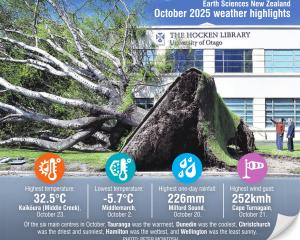And there could be more stormy seas ahead as the crew begins the latest stage in the quest for finding petroleum reserves off Dunedin's coast.
They plan to spend the next two months using a range of expensive 3D seismic scanning equipment to scour 1150sq km of sea floor between 30km and 50km east and northeast of Dunedin, up to 1100m deep on the edge of the continental shelf.
The $13-million array of imaging equipment will be towed in six "streamers" up to 5.1km behind the vessel's stern, in a spread more than 600m wide, as the vessel makes multiple passes over the search area.
The result will be up to 30 terabytes of raw data producing an image similar to an ultrasound, to be pored over by geophysicists searching for clues about the potential for finding petroleum reserves in rock formations below the sea.
Bad weather could provide one of the bigger hurdles for the crew and could extend the expedition into a third month if predicted stormy weather eventuates.
The vessel, owned by Norwegian-founded multinational company PGS (Petroleum Geo-Services), is contracted to Australian-listed oil company Origin Energy, which holds a permit to explore for petroleum in the area.
Yesterday, during a tour of the vessel, PSG chief quality control geophysicist David Cox told the Otago Daily Times forecasts showed the weather could become "pretty awful".
"It's been indicated the weather could be quite bad out there and that's something we haven't seen that much. It's not going to be nice," he said.
The vessel had largely operated in the calmer waters of the Asia-Pacific region during the past 12 years, encountering fewer storms than would be experienced in the waters around southern New Zealand.
It was the first time a vessel with such sophisticated 3D imaging equipment had been used off the coast of Otago, he said.
"It's a pretty nondescript part of the world," Origin project liaison Bruce Morris, of New Plymouth, said of the search zone yesterday.
"There's not much there. It will be just open ocean and you won't be able to see land."
If the weather became too bad, the ship might be forced to delay its planned measurement activities or even "run for cover", Mr Cox said.
However, that sort of decision would not be taken lightly, given the seismic array took up to two days to deploy from giant rollers located in the vessel's stern.
Commercial fishermen and other boat owners were being warned to keep well clear of the vessel and its trailing equipment, and an accompanying chase boat would shepherd away any that strayed too close.
Members of the vessel's crew would also be on the lookout for whales and other marine life, and could stop work if their health was threatened, he said.
The 81.1m-long, 3922-tonne vessel was built in Norway in 1986, and operated in waters around Europe, Mexico and Africa before moving into the Asia-Pacific region in 1996.
The vessel's crew - including a 20-strong seismic team - are from Norway, England, Scotland, Singapore, Australia and New Zealand, and are typically on board for five weeks before being replaced by fresh crew flown in by helicopter.
A resupply vessel was used to ferry fresh food to the vessel, allowing it to stay at sea longer, Mr Cox said.
Origin geophysical operations manager Neil Millar said the search area was the company's biggest individual site to be explored, and encompassed the Carrack and Caravel prospects already explored by Origin during a hydrographic survey.
The two prospects were estimated to contain possibly 750 million barrels of recoverable oil, or 2700 petajoules of recoverable gas and 500 million barrels of associated condensate if it was gas-charged, Origin manager of investor relations Angus Guthrie said in August.
However, any decision to develop a commercial field was likely to be several years away, once the "huge amount" of new data collected was scrutinised, Mr Millar said yesterday.












